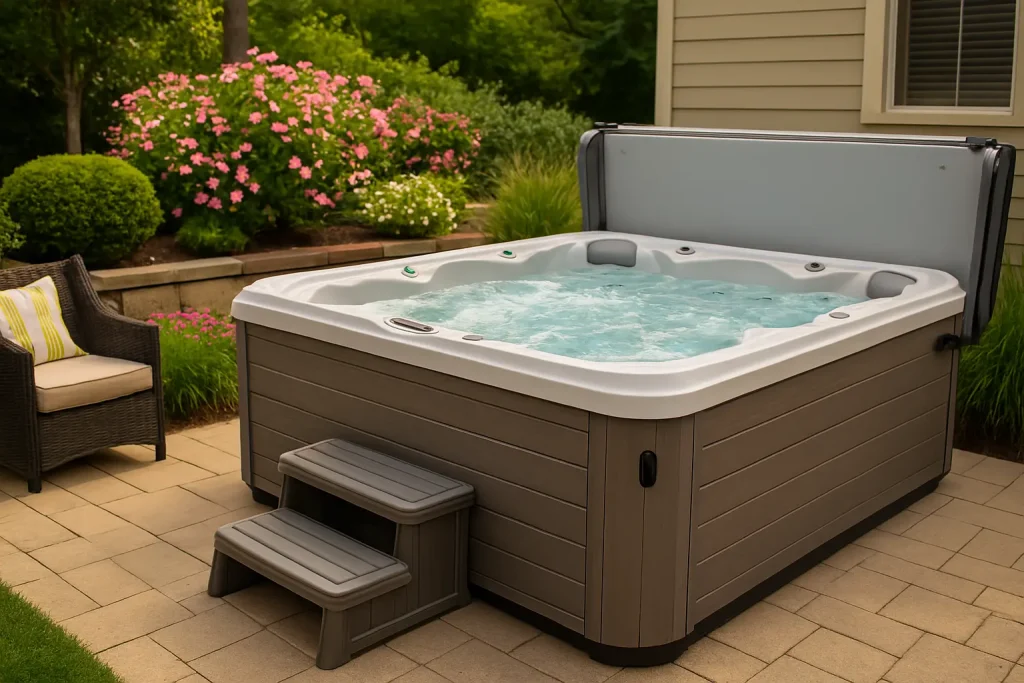
Hot Tubs & Spas – Buyer’s Guide
Thinking about adding a hot tub or spa to your backyard? Whether you’re seeking a peaceful soak under the stars or relief for sore muscles, investing in a spa is a great way to upgrade your home and enhance your wellness. But with so many options available — from portable plug-and-play tubs to fully built-in custom spas — it can be hard to know where to begin.
In this buyer’s guide, we’ll walk you through everything you need to know before buying a hot tub or spa: types, features, sizing, costs, installation, and maintenance considerations — so you can find the perfect fit for your space, lifestyle, and budget.
Hot Tub vs. Spa: What’s the Difference?
Although the terms are often used interchangeably, there are some distinctions:
- Hot Tub: Usually refers to a self-contained, portable unit with jets and a built-in heater. Most run on electricity and can be plugged into a standard outlet or hardwired.
- Spa: Often refers to an in-ground or custom-built hot water feature that’s integrated with a pool or patio design, sometimes sharing heating and filtration systems with a swimming pool.
For simplicity, we’ll use the term “spa” throughout this guide to include both hot tubs and custom spas.
Types of Hot Tubs & Spas
1. Portable Hot Tubs
These are pre-manufactured acrylic or rotomolded units that can be placed almost anywhere on a solid surface. They’re plug-and-play or require 220V wiring and come with everything built in — jets, controls, pumps, and heating.
- Pros: Easy to install, affordable, lots of models to choose from
- Cons: Less customizable, limited in size or built-in features
2. In-Ground Spas
Custom-designed spas that are built into the landscape, often using gunite, concrete, or tile. Can be standalone or integrated with a pool.
- Pros: Luxurious look, highly customizable, blends with outdoor design
- Cons: Expensive, requires excavation and professional installation
3. Swim Spas
A hybrid between a pool and a hot tub, swim spas are longer units that allow for resistance swimming on one side and hydrotherapy seating on the other.
- Pros: Fitness + relaxation in one, compact alternative to a pool
- Cons: Higher cost, requires more space and power
4. Inflatable Hot Tubs
The most budget-friendly option. These air-filled tubs are portable and great for short-term or seasonal use. Just inflate, fill, and plug in.
- Pros: Super affordable, portable, easy setup
- Cons: Not as durable, limited jet power, not ideal for winter use
How to Choose the Right Spa
- Capacity: How many people will regularly use the spa? Models range from 2-person soakers to 8+ party tubs.
- Jets & Seating: Consider massage jet types, ergonomics, and whether you want loungers or upright seats.
- Space & Location: Make sure the unit fits your yard, deck, or patio — and check for access to electricity and drainage.
- Climate: If you live in a cold area, look for well-insulated models and consider winterization features.
- Budget: Portable hot tubs range from $3,000–$15,000; in-ground spas often exceed $20,000.
Take a soak test if possible — many dealers offer private in-store demos where you can sit in a filled tub before buying.
Features Worth Considering
- LED Lighting: For nighttime ambiance and visibility
- Waterfalls & Fountains: Add visual and auditory relaxation
- Bluetooth Audio: Built-in speakers for music or guided meditation
- Ozonators or Salt Systems: Improve sanitation with less chemical use
- Wi-Fi Controls: Remote monitoring and control via smartphone
These features can enhance your experience but may increase the overall price, so choose based on what really adds value for your lifestyle.
Installation and Maintenance
Installation needs vary based on type:
- Portable tubs: Often plug into standard 110V or 220V outlet. May need a concrete pad or reinforced deck.
- In-ground spas: Require excavation, permits, and professional construction.
- Swim spas: Usually need a concrete base, crane delivery, and dedicated electrical line.
Regular spa care includes water testing, balancing chemicals, cleaning filters, and occasionally draining and refilling. Most spas need weekly attention to stay clean and safe.
Final Thoughts
Hot tubs and spas offer incredible benefits — from stress relief and pain management to socializing and year-round enjoyment. Whether you want a cozy 2-person tub or a luxury in-ground spa, the key is matching your purchase to your needs, space, and long-term expectations.
